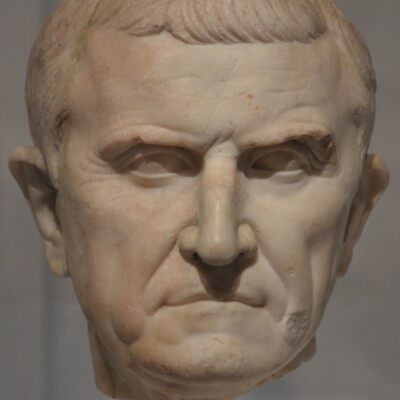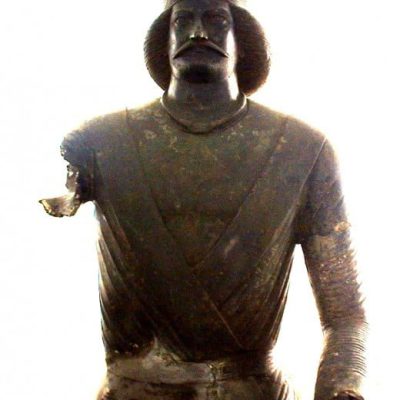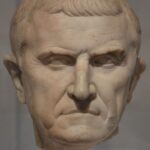Chapters
Conflicts between Rome and the Parthians began in 53 BCE when Roman legions, led by Commander Marcus Crassus, entered Mesopotamia.
Background of events
The armed conflict between Rome and the Parthians began in 53 BCE, with Parthian-controlled Mesopotamia the Roman legions, led by the general of Marcus Crassus, entered. In Iran, there had been a war between King Elymaida, Orodes, and his brother, King of Media, Atropatene Mithridates, for the throne of the King of Kings since about 58 BCE.
Crassus hoped he would get involved in the dispute or take advantage of the brothers’ involvement in the struggle among themselves and seize the rich Mesopotamia, and perhaps even permanently depend a powerful and vast Party state on itself and Rome.
Crassus made alliances with the disobedient Parthian vassals: King of Armenia Artavazdes II and King Osroene Abgar II. 36,000 Romans (35,000 infantry, 1,000 cavalry) fought a battle near Carrhae City of over 10,000 Party riders led by prince Eran of the Suren clan, one of the party’s most distinguished families. The Arsacid dynasty was of Scythian origin and brought Scythian patterns to Iran. The mounted archers, using their speed, showered the Roman infantry with a barrage of arrows, not letting them get close. Roman troops disintegrated, with only 10,000 legionaries escaping death or captivity. The captured prisoners and the legionary banners Parthians returned to Rome only after 33 years.
The son of Crassus was killed in the battle, Crassus himself was killed after the battle during negotiations with the Parthians at the hands of a minor commander, the proconsul’s head was taken to the court of Orodes, where it was used as a prop in the staging of Euripides’ Bacchae.
Parthian invasions of Syria
Two years after this victory, the Parthians struck the lands of the Roman Empire. Orodes dispatched troops led by his son, Co-Governor of Pakorus. Crassus’ Quaestor, Gaius Cassius Longinus (Caesar’s future killer) gathered what was left of his superior’s army and repelled the young king’s attack. He had to Pacorus resign from further actions, because his father, not even trusting his own son, called him to Ctesiphon.
In 46 BCE, Pakorus returned to Syria and joined the fights between Caesar’s parties and Pompey’s followers. The late season discouraged him, however, and he turned back. They were more successful in 40 BCE. In Palestine, there was a succession conflict between the representatives of the Maccabean dynasty: John Hirecan II and Antigonus. Pokorus invaded Palestine, placed Antigonus on the throne in Jerusalem and handed over Hirkana to the satrap of Upper Mesopotamia. Meanwhile, Titus Labienus, the Roman commander and supporter of Caesar’s assassins, whom Cassius had sent to Orodes for help during the war with Marcus Antony, at the head of another army took Syria and almost all of Asia Minor. Parthians seemed to be fulfilling their dream of restoring Iranian power in the former western provinces of the Achaemenid Empire. However, the disagreements between Pakorus and Labienus made it easier for the Romans to act. Mark Antony sent his legate, Ventidius, to Syria to defeat Pacorus’s forces at Amanus in 39 BCE and Gindarus near Antioch in 38 BCE, taking advantage of the tactical errors of the Parthian command. Meanwhile, Labienus was driven out of Anatolia. In the same year, Pakorus was killed and the Parthians withdrew from Roman lands.
Expedition of Marcus Antony
Marcus Antony tried to make his dreams come to true Julius Caesar and Cleopatra and conquer the Parthian lands, but despite the gathering of 100,000 soldiers, his expedition ended in failure.
Phraates IV: King of Armenia Artawazdes II and King of Media Atropatene Artawazdes I. The defeat at Fraaspa and supply problems forced him to withdraw. The defeat did not prevent Antony from declaring in Alexandria in 34 BCE King of Kings Caesarion (son of Caesar and Cleopatra), Alexander Helios king of Armenia, and carving out the children of Cleopatra and his kingdom in Party territory and Roman. In 33 BCE there was a second unsuccessful invasion of the Parthian Empire by Antony.
Roman-Parthian wars in the 1st century CE
In 20 BCE a revolution took place in Armenia: Artaxes II, who favoured the Parthians, was overthrown and elevated to the throne, advocating rapprochement with Rome and ready to acknowledge the sovereignty of Emperor Tigranes III. Augustus sent Tiberius to crown Tigranes III on his behalf and support the Parthian usurper, Tiridates II. Fighting him tied the hands of King of Kings Phraates IV. Fraates could not afford to fight the Romans and returned Crassus’ legionary banners. Augustus flaunted this “victory”, but centuries of Roman-Parthian struggles for Armenia began.
The emperors of the Julio-Claudian and Flavian dynasties pursued a policy of strengthening Rome’s presence in the east by annexing vassal frontier kingdoms (Cappadocia, Kommagene, Little Armenia, Paphlagonia), which, of course, was not conducive to good relations with the Parthians seeking to rebuild the Achaemenid power. In 18 CE, Orodes, the king of Armenia from the Arsacid family (ruling house in Iran), died. Artaxes III was elected that king and Tiberius approved the election and made him his vassal. Parthian King Artabanus II, struggling with internal difficulties, did not intervene at first, but in 35 CE he sent his son, Arsakes, to take Armenia. Tiberius sent the king of Iberia, Mithridates, against the Parthians, who entered Armenia and encouraged Tiridates, a relative of Artabanos, to rebel. A new civil war broke out in Iran, in which the governor of Syria, Vitellius, was involved. Artabanus defeated the challenger but did not regain Armenia.
In 51 CE, Mithridates, ruler of Iberia and Armenia, was murdered. The governor of Cappadocia entered Armenia, and this prompted the reaction of King of Kings Vologezes I. He placed his brother Tiridates I in Armenia. Nero sent Gnaeus Domitius Corbulo to sort things out. Corbulo sent a protest to Wologezes, who initially relented, but gathered his strength to fight Rome. The Romans did the same (neither side was sure of the advantage). Tiridates attacked in 57 CE. In the first skirmish somewhere on the Euphrates, he defeated Roman forces and took Armenia. However, he avoided a major battle and allowed Corbulo to enter his country. Wologezes, preoccupied with the uprising in Hyrcania and the Kushan invasion of Bactria, could not help his brother. Corbulo burned Artaxata and in 59 he set off for Tigranocerta. The Romans restored Tigranes VI to power.
The Roman-Parth War for Armenia (CE 58-63)
In CE 61, Tigranes VI invaded Mesopotamia, to which the Parthians responded by re-seizing Armenia and removing him from the throne. In CE 62, while Wologezes besieged Tigranes in Tigranocert, Corbulo made a truce with the Great King. Later that same year, the governor of Cappadocia, Cessenius Petus, entered Armenia but was defeated at Randeja. Corbulo broke into Mesopotamia but turned back at the news of Petus’ defeat. The truce was renewed: henceforth Tiridates, brother of the Parthian king, ruled in Armenia, but as a vassal of Nero. In CE 66, Tigranes paid tribute to Nero. This compromise, despite numerous wars that followed, proved to be permanent.
Trajan’s Expedition
In 113 CE, the emperor Trajan directed all power of Rome against the Parthians and, by 115 CE, Assyria and Mesopotamia, he conquered Ctesiphon and reached the Persian Gulf by the Tigris. Then the Roman legions could, for the first and last time, experience bathing in the waters of the bay. He placed his protégé on the Parthian throne, and the rightful great king, Orodes, fled deep into Iran. However, the conquered lands remained under Roman rule only for a while, as the Mesopotamian uprising forced Trajan to withdraw, and Hadrian, who became emperor in CE 117, he ordered the captured provinces to leave due to the excessive cost of their defence and constant threat.
Roman-Parthian wars in the 2nd century CE
Another war between Rome and the Parthians broke out in 162 CE when the party armies of Vologezes IV stormed Asia Minor, where they defeated the forces of the Cappadocian governor, Sedatius Severian, and Syria, where they defeated the Romans at Elegya. Marcus Aurelius tried to strike a compromise deal, but the King of Kings persisted. A year later, the Roman army led by the emperor Lucius Verus entered Armenia and Mesopotamia, defeating the Parthians at Dura-Europos and then burning Artaxata, Seleucia, and Ctesiphon in 165 CE, then headed deep into the Iranian Highlands, where she was arrested and forced to retreat by the plague. The soldiers returning home dragged the disease to Rome.
During the war, Septimius Severus with Pescenius Niger The Great King Vologezes V volunteered to support the latter, and King Osroene Abgar IX declared independence. In 193 or 194 CE, Severus entered Mesopotamia, annexed Osroene, turning it into a province, and then entered Media Adiabene and made peace with the Parthian king. In 197 CE, Wologezes attacked Nisibis. The emperor returned to the East and took Ctesiphon. The Parthians had to hand over much of Mesopotamia to the Romans, however Roman rule over the Euphrates and the Tigris ended after the death of Septimius Severus.
Caracalla Expedition
The last emperor to make an expedition against the Parthians was Caracalla, who, like Trajan, dreamed of repeating the deed of Alexander the Great. Another civil war in Iran (Wologezes VI fought against Artabanus IV) and the slow disintegration of the Parthian empire was to aid him in the victory. In 216 CE, the emperor annexed Armenia and entered Mesopotamia and then Media. He was murdered by Marcus Opilius Macrinus, who seized power. Macrinus lost the Battle of Nisibis and was forced by Artabanus IV to pay a war contribution of 200 million sesterces. The treaty between Nero and Vologezes I was renewed, and Tiridates IV of the Arsacid family became king of Armenia.
The continuing wars with Rome, internal unrest and raids by nomads weakened the Parthians and they were overthrown in the mid-20s of the 3rd century CE by the Persian Sassanid dynasty (their vassals), who quickly wanted to expand their empire.










